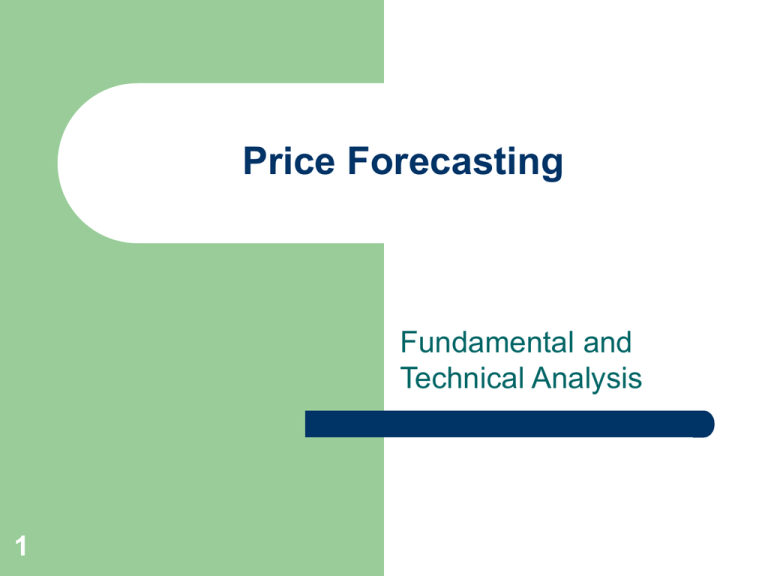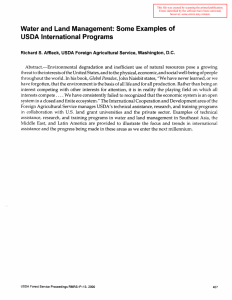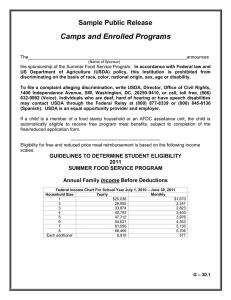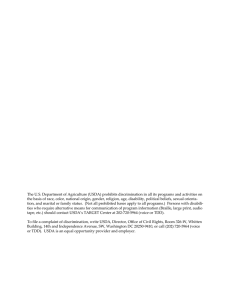Price Forecasting Fundamental and Technical Analysis 1
advertisement

Price Forecasting Fundamental and Technical Analysis 1 Fundamental Analysis Fundamental analysts assess commodity price implications by evaluating supply and demand variables. These include: Seasonal Use Patterns Seasonal Supply Patterns Price of Substitute Goods Price of Compliment Goods Market Structure (how many buyers and sellers) 2 Strategy Using economic theory, predict the (usually) long-run market clearing price. If the asset is overvalued relative to the expected market clearing price, then the asset is sold. If it is over valued, it is bought. The result is a long-run approach to price forecasting. 3 Hypothesis Every asset has some intrinsic value or price Econ: equilibrium or market clearing price Finance: Fair market value However, because market forces are complex and ever changing, prices can be distorted. This can result in an asset being over or under valued at any given point in time. 4 Demand Factors 5 Current Price Level Prices of substitutes or compliments Income Exchange Rates Trade Agreements Government Programs Supply Factors 6 Factors of Production Inventory Levels Carryover Government Programs Production in other Countries Weather Approaches to Fundamental Analysis 7 Intuitive Analysis Use a basic understanding of economic principles to hypothesize about prices Quantitative Analysis Combine knowledge of economic theory with mathematical and statistical techniques to establish explicit relationships between economic variables and prices. US Corn Balance Sheet (Sep/Aug) Marketing Year USDA 96/97 USDA USDA 97/98 98/99 M illion Bushels 426 883 1,308 13 9 19 Beg Stocks Imports 1,558 16 Acres Planted Acres Harvested % Harvested Yield Production Total Supply 71.2 65.0 91.3% 113.5 7,374 8,948 79.2 72.6 91.7% 127.2 9,233 9,672 79.5 72.7 91.4% 126.6 9,207 10,099 Feed & residual Food/Seed/Ind. Exports Total Demand 4,696 1,598 2,228 8,522 5,302 1,692 1,795 8,789 Ending Stocks Stocks To Use 426 5.00% $3.24 Avg. Farm Price 8 USDA 95/96 12/05/00 USDA 99/00 USDA OCT 00/01 USDA NOV 00/01 1,787 15 1,715 10 1,715 10 80.2 72.6 90.5% 134.4 9,759 11,085 77.4 70.5 91.1% 133.8 9,437 11,239 79.6 73.0 91.7% 139.6 10,192 11,917 79.6 73.0 91.7% 137.7 10,054 11,779 5,505 1,782 1,504 8,791 5,496 1,822 1,981 9,298 5,676 1,913 1,935 9,524 5,850 1,975 2,275 10,100 5,850 1,975 2,275 10,100 883 10.04% 1,308 14.88% 1,787 19.22% 1,715 18.01% 1,817 17.99% 1,679 16.62% $2.71 $2.43 $1.94 $1.80 $1.85 $1.90 Leading Indicator Models Assume prices do not respond immediately to new information. Attempt to determine the final price response, and how long it will take. Indicator Market USDA Crop Production Soybeans UDA Cattle on Feed Cattle 9 November Price - Dec Futures vs. Ending Stocks 3.5 3.3 1995 3.1 2.9 $/bushel 1996 2.7 1997 2.5 1991 1993 1990 2.3 1994 2.1 1998 1992 1999 1.9 1.7 0 10 500 1000 1500 2000 2500 In October, USDA estimated the 2000/01 corn carryout would be about 1.8 billion bushels. At that time the price for December corn futures was less than $2 per bushel. Using historical relationships, a 1.8 billion bushel carryout implies an average price in November for December corn futures of $2.10 per bushel. 11 12 Summary Fundamental forces are those that deal with the basic concepts of supply and demand. Fundamental analysis applies the understanding of these relationships to the expected price formation of a commodity. However, the price forecast is only as good as : 1) the basic understanding of underlying economic conditions, and 2) the ability to accurately anticipate changes in current economic conditions. 13 Technical Analysis Technical analysts assess commodity price implications by evaluating past prices and market activity (trade volume and open interest). 14 Strategy Using past prices and market activity levels, predict the (usually) short-run variations in price. The result is a short-run approach to price forecasting. It addresses the question “how will we get to the market equilibrium price?” 15 There are an infinite number of ways to measure past price performance 16 Bar Charts Lines of Support and Resistance Consolidation Planes Key Reversals Price Gaps Moving Averages Bar Chart 17 Price is plotted on the vertical axis A time interval is plotted on the horizontal axis The bar chart plots the range of price experience over the time interval 18 Trend Lines 19 Used to get more specific information from a bar chart. Estimates the exact price at which a trend reverses. 20 Consolidation Planes 21 Identifies an expected trading range when no trend is present (sideways market). Traders buy at the bottom and sell at the top of the range until the pattern is violated. 22 Key Reversal Indicates a change in trend. Also called an outside day because the extreme price (high and low) are both outside the previous day’s trading range. 23 24 Gaps Reflects a strong change in the supply/demand assessment of the market, or a change in the general interpretation of existing market information. Two interpretations: run from the gap fill the gap 25 26 Moving Averages Attempt to smooth out daily price fluctuations so an analyst might get a better idea of the underlying trend. Trading signals are generated when prices cross the moving average. 27 28 Summary Technical analysis can be a powerful tool in picking market entry and exit points, but: – – – 29 Selecting the time frame over which an indicator is generated is completely arbitrary BUT critical. In general, the longer the time frame the accurate the signal, but the less often there will be a signal. Technical rules can be self-fulfilling which is NOT indicative of some irreversible market rule. Most technical traders look at a whole portfolio of indicators. Focusing on just one is extremely dangerous.




